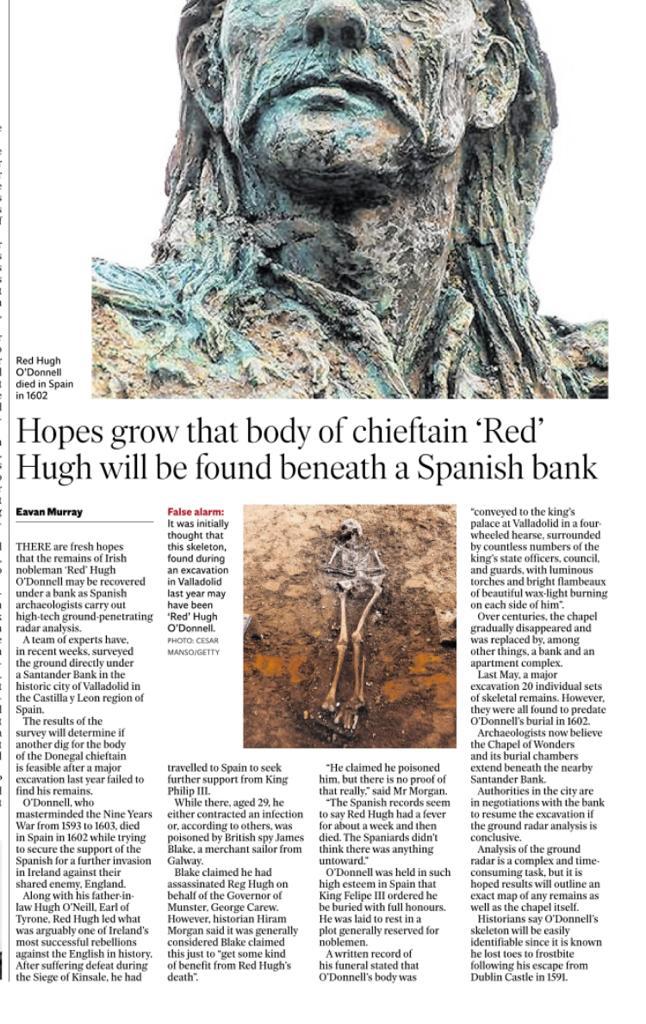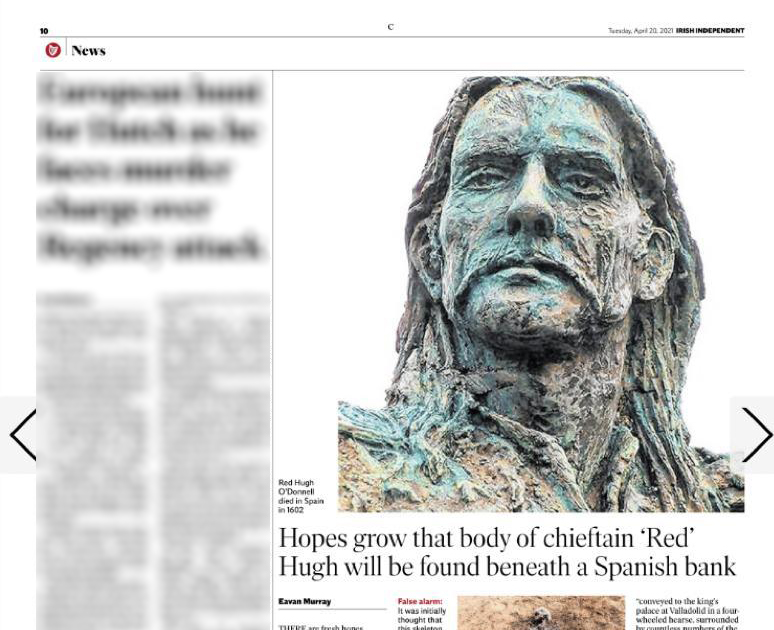Dublin, 20 April 2021(Irish Independent). By Eavan Murray.- There are fresh hopes that the remains of Irish nobleman ‘Red’ Hugh O’Donnell may be recovered under a bank as Spanish archaeologists carry out high-tech ground-penetrating radar analysis.
Dublin, 20 April 2021 (The Irish Independent).-
There are fresh hopes that the remains of Irish nobleman ‘Red’ Hugh O’Donnell may be recovered under a bank as Spanish archaeologists carry out high-tech ground-penetrating radar analysis.
A team of experts have, in recent weeks, surveyed the ground directly under a Santander Bank in the historic city of Valladolid in the Castilla y Leon region of Spain.
The results of the survey will determine if another dig for the body of the Donegal chieftain is feasible after a major excavation last year failed to locate his remains.
O’Donnell, who masterminded the Nine Years War from 1593 to 1603, died in Spain in 1602 while trying to secure the support of the Spanish for a further invasion in Ireland against their shared enemy, England.
Along with his father-in-law Hugh O’Neill, Earl of Tyrone, Red Hugh led what was arguably one of Ireland’s most successful rebellions against the English in history.
After suffering defeat during the Siege of Kinsale, he had travelled to Spain to seek further support from King Philip III.
While there, aged 29, he either contracted an infection or, according to others, was poisoned by British spy James Blake, a merchant sailor from Galway.
Blake claimed he had assassinated Reg Hugh on behalf of the Governor of Munster, George Carew. However, historian Hiram Morgan said it is generally considered Blake claimed this just to “get some kind of benefit from Red Hugh’s death”
“He claimed he poisoned him, but there is no proof of that really,” said Mr Morgan.
“The Spanish records seem to say Red Hugh had a fever for about a week and then died. The Spaniards didn’t think there was anything untoward.”
O’Donnell was held in such high esteem in Spain that King Felipe III ordered he be buried with full honours.
He was laid to rest in a plot generally reserved for noblemen, earls and bishops in the Chapel of Wonders at the convent of San Francisco in Valladolid.
A written record of his funeral stated that O’Donnell’s body was “conveyed to the king’s palace at Valladolid in a four-wheeled hearse, surrounded by countless numbers of the king’s state officers, council, and guards, with luminous torches and bright flambeaux of beautiful wax-light burning on each side of him”.
Over centuries, the chapel gradually disappeared and was replaced by, among other things, a bank and an apartment complex.
Last May, a major excavation at the site adjacent to the bank unearthed 20 individual sets of skeletal remains. However, they were all found to predate O’Donnell’s burial in 1602.
As a result of that dig, archaeologists now believe the Chapel of Wonders and its burial chambers extend beneath the nearby Santander Bank.
Authorities in the city are in negotiations with the bank to resume the excavation if the ground radar analysis is conclusive.
Analysis of the ground radar is a complex and time-consuming task, but it is hoped results will outline an exact map of any remains as well as the chapel itself.
Historians say O’Donnell’s skeleton will be easily identifiable since it is well documented that he lost toes to frostbite following his escape from Dublin Castle in 1591.








Post a comment